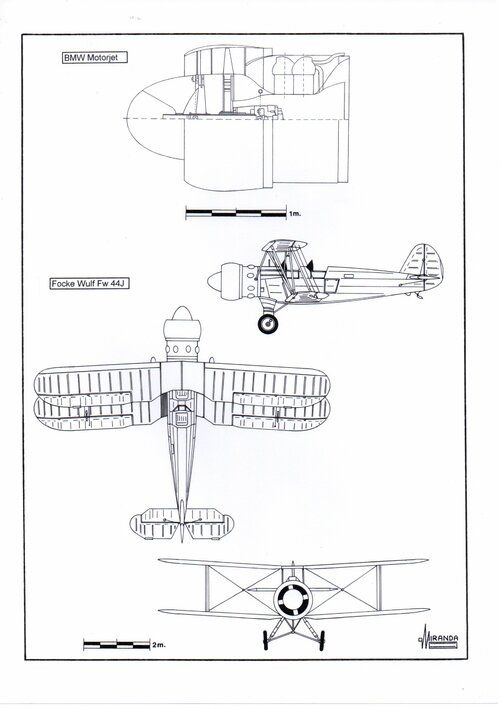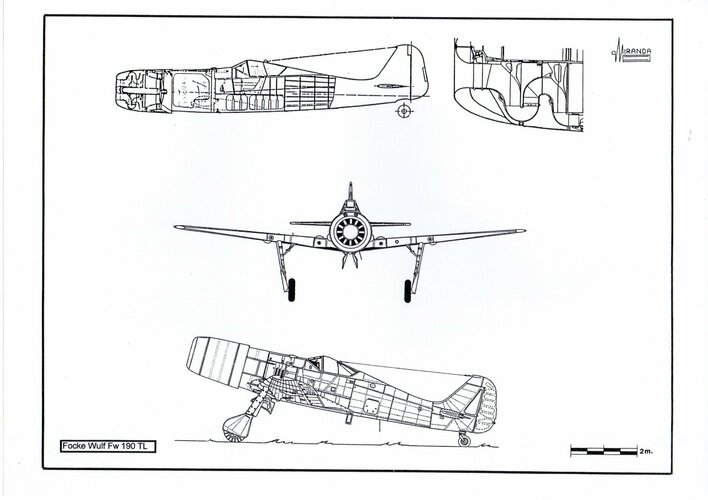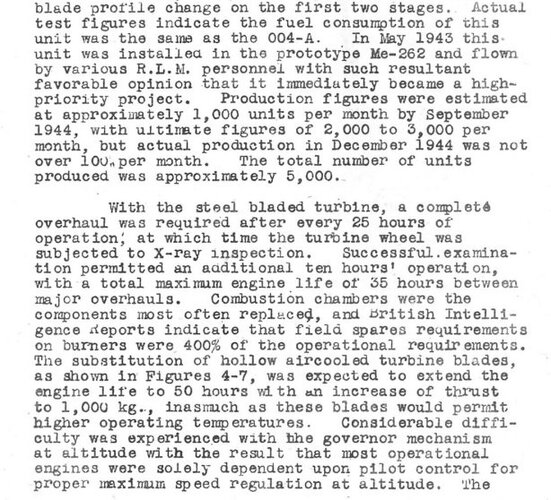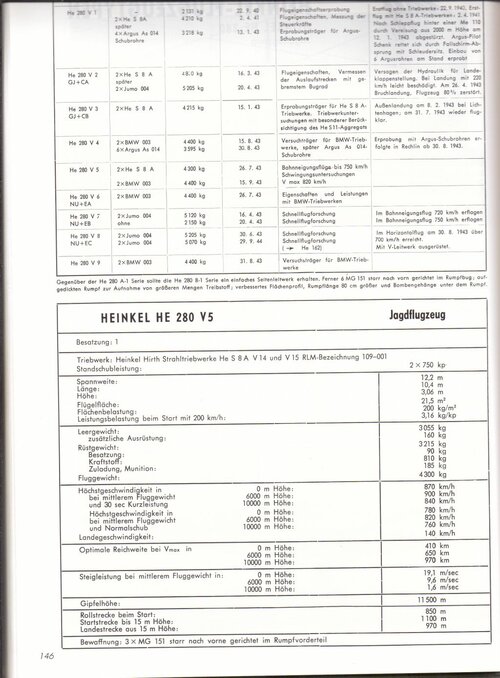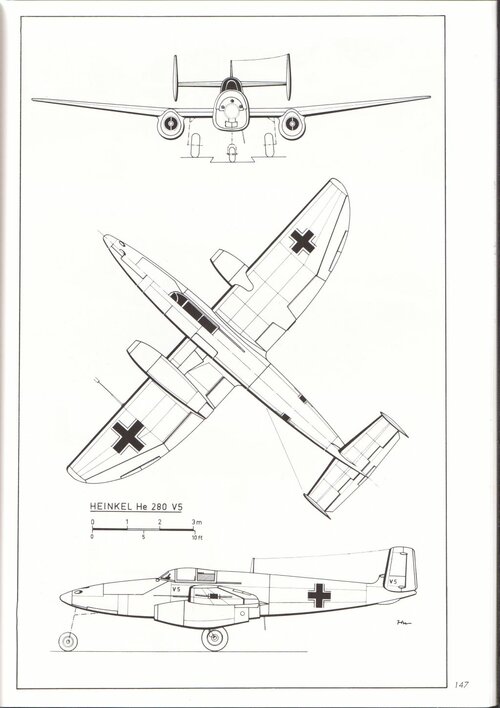In April-May 1945 twelve BMW 003 A turbojets were taken by Soviet troops at Breslau-Lower Silesian, one in Vienna-Hinterbruehl, blueprints and several engines at Basdorf-Zühlsdorf and eleven semi-destroyed turbojets at Heidfield.
Two Heinkel He 162 A-2 jet fighters, powered by BMW 003 A-1 engines, six HeS 8a and nine Jumo 004 B turbojets were captured at Heinkel-Vienna facilities.
Two BMW 003 E engines, along with a complete set of drawings, at Heinkel-Rostock factory.
One Arado Ar 234 C-3 bomber powered by four BMW 003 A-1 engines was seized in Damgarten, and their blueprints were found buried in the ground at the Arado-Brandenburg firm.
Several Jumo 004 B turbojets were captured at Brandis-Leipzig and ten at CKD-Prague works.
At Muldenstein Werke AG, Ascherleben FZA, Junkers-Ebersbach, Koethen MZK-Merseburg and Lindenthal-Leipzig underground facilities the Soviets captured enormous stocks of Jumo 004 B components and the technology for manufacturing and testing turbojets.
Documentation and some parts of the Jumo 012 turbojet were captured at Dessau, Brandis, Aken and Mosigkau facilities.
The destroyed prototype of the BMW 018 turbojet captured by U.S. troops at Stassfurt was handed over Soviet occupation forces.
When some samples of Jumo 004, BMW 003 and HeS 8a engines were bench tested, in August 1945, by the TsIAM scientists it was discovered that the construction of German turbojets required enormous technical and manufacturing resources that were not available in the USSR.
The high temperatures and high rotation speeds reached by the turbine blades required the use of austenitic steel alloys to withstand stresses caused by centrifugal forces.
The precision machining of these heat-resisting parts could only made possibly by sophisticated machine tooling and highly-skilled labor force.
Jumo 004 B-1 turbine blades were made of the 580ºC heat-resisting steel alloy Krupp-Essen Tinidur (C, Si, Mn, Ti, Ni, Cr, Fe).
The air compressor casing was made of Electron Magnesium alloy and the turbine discs were built in forged Molibdenum steel.
Other parts of the engine were made of aluminized anti-corrosion mild steel, to achieve this material the Germans had developed the manufacturing process called Aluminitieren.
It was also necessary to develop a new procedure for welding the solid turbine blades, the WMF atomic hydrogen welding process.
In order to increase the life of the turbine Junkers, tried making air-cooled hollow blades, but the Tinidur sheet proved unsuitable for welding.
A new manufacturing process was developed by William Prym-Stolberg using Degussa Flussmetal (85% Ag, 15% Mn), Silma solder and Lithium fluoride at 1,000 ºC.
In August 1944 production of hollow blades started at Prym-Zweiffall factory and the whole project was classified secret.
The main Junkers plant at Dessau was heavily bombed in late 1943 and the Jumo 004 B-2 production was taken over by Köthen and Muldenstein satellite factories in August 1944.
When the Nickel became extremely scarce in the Reich, after their supply lines of Finnish ore were cut off, Krupp-Essen developed the heat-resisting alloy known as Cromadur (Mn, Cr, V, Si, C, Fe). It was easy to weld and it was used for the manufacture of the Jumo 004 B-4 air-cooled hollow blades.
Jumo 004 was developed from the beginning to run on diesel oil, but the BMW 003 availability suffered delays when converted to diesel and the BMW-Bramo’s Spandau plant was bombed in 1943.
By August 1944 it was finally ready for mass production, under SS control, in underground dispersed sites of SS-Kraftfahrttechnischen Versuchsanstalt-Oranienburg, Eisenach, Zühlsdorf, Nordhausen, Wittringen and Stassfurt.
The BMW 003 air compressor forged blades were of Normen Nº 3510 Magnesium alloy and the compressor discs of Normen Nº 3115 Duralumin.
The turbine blades were made of Sicromal 10 heat-resisting steel (Cr, Al, Si, C, Fe), FBD Chrome-Nickel steel (Cr, Ni, Mo, Ta-Nb, Si, C, Fe) and FCMD steel (Cr, Mn, Mo, Nb, Si, V, C, Fe).
The turbine discs were made of steel alloy (Mn, Cr, Mo, Si, C, Fe) and the cooling insert of the blades of WMF Remanit 1880S Chrome-Nickel steel.
Other parts of the engine had undergone an anti-corrosion treatment, based on Aluminum laquer paint, developed by Zarges-Weilheim.
When the Soviets realized the difficulties they would have to overcome in obtaining reverse-engineered copies of the German turbojets they decided to continue production in the numerous underground facilities that had survived the Allied bombings.
But they were forced to change their plans because inter-allied peace treaties prohibited the manufacture of weapons in Germany.
On October 22, 1946 a crash program was initiated to produce these engines in the USSR, a task in which the Soviets were much assisted by German, Austrian and Czech technicians to adapt the German technology to Soviet manufacturing standards.
A training program of Soviet technicians was also conducted at GAZ-19 Kuibyshev establishment.
Tools, equipment and engine parts from Junkers-Ascherleben FZA, Junkers-Ebersbach, Junkers-Muldenstein, Junkers-Köthen, Junkers-Lindenthal and Junkers-Schoenebeck underground factories were transferred to GAZ-437 Kiev, GAZ-4 and GAZ-27 Moscow, GAZ-26 Ufa and GAZ-86 Taganrog.
In late 1946, 59 Jumo 004 B-1 turbojets were assembled into GAZ-19 Kuibyshev, using components from CKD-Prague.
Another 447 Jumo 004 B-2 engines were assembled into GAZ-26 Ufa using components captured at Muldenstein Werke AG.
Both the Jumo 004 B-1, with solid turbine blades and the Jumo 004 B-2 with Tinidur air-cooled blades assembled in USSR received the RD-10 codename.
The RD-10 turbojets suffering from low reliability, the time between overhauls was officially claimed to be 25 hours, but in reality it was 17 hours at best.
In 1947 the manufacture of 883 Jumo 004 B-4 turbojets at the GAZ-10 Kazan began under the name RD-10 A.
Having raw materials previously unavailable for the Germans, the Soviet version had between 30-40 hours extended service life and slightly increased thrust.
In 1948, the Jumo 004C with afterburner was put in production, as RD-10F, at the GAZ-10.
The RD-10 (first version) had 900 kg thrust, the RD-10 (second version) 910 kg, the RD-10 A 1,000 kg and the RD-10 F 1,100 kg.
Production of BMW 003 A-1 copies which were designated RD-20, started in 1947 at GAZ-466 Leningrad and GAZ-19 Kuznetsov plants.
The Soviet version from Kazan factory Nº 16, with 50 hours extended service life, was named RD-20F and the Soviet version of the BMW 003 S, an afterburning variant of the RD-20, was named RD-21.
The RD-20 had 850 kg thrust, the RD-20 F had 1,000 kg and the RD-21 had 1,050 kg.

